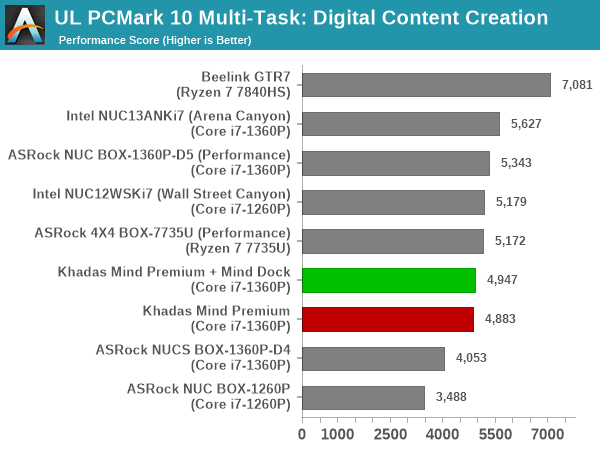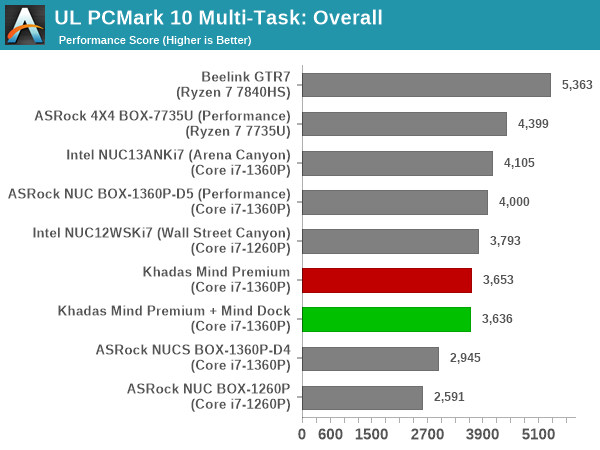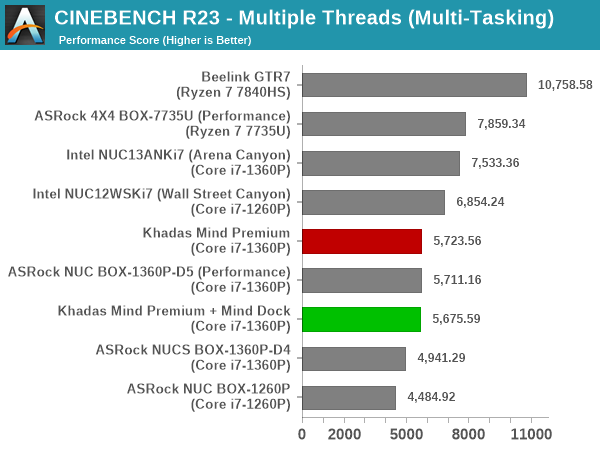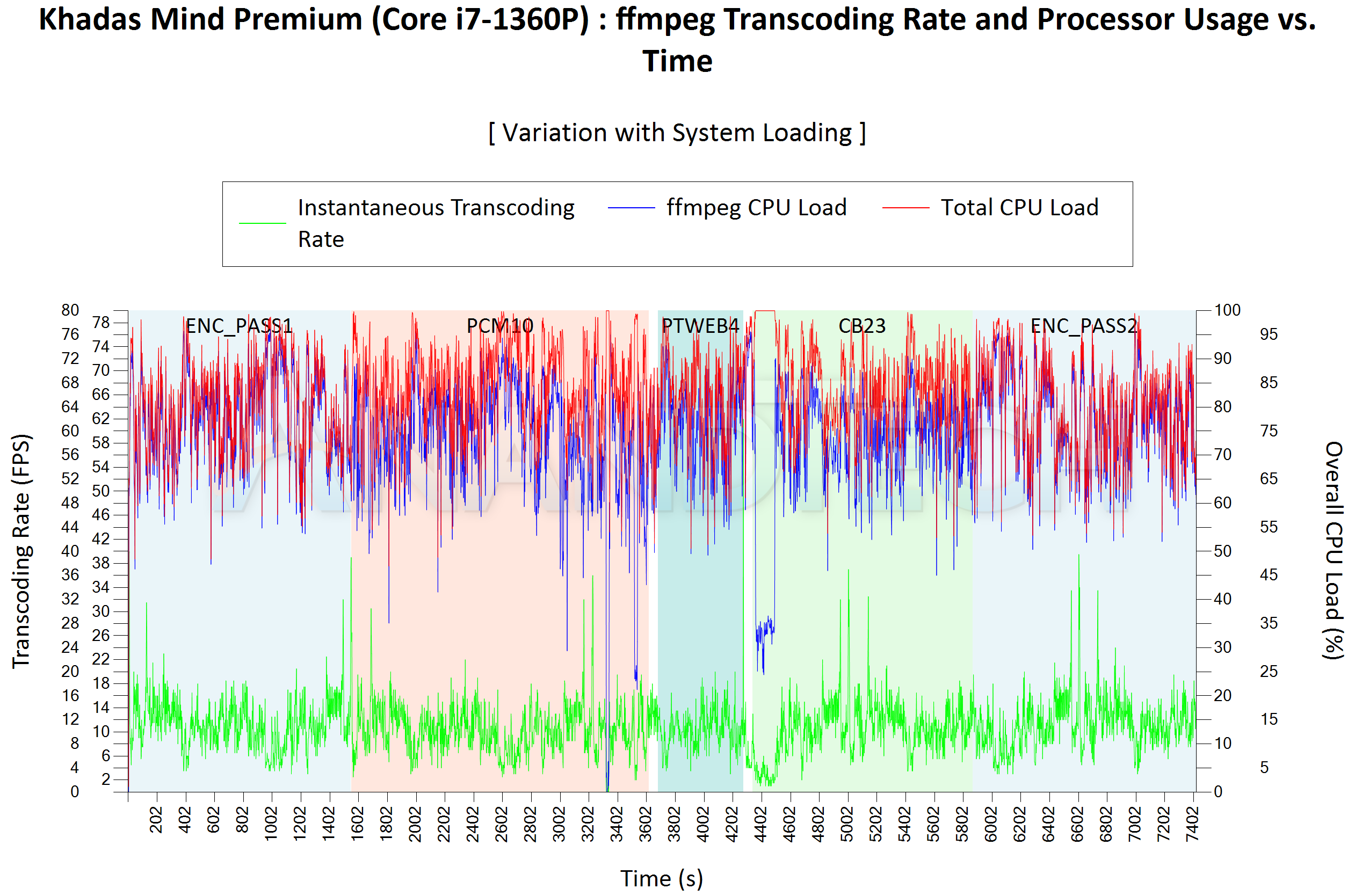Khadas Mind Premium Review: Raptor Lake-P in a Modular Portable Workstation
by Ganesh T S on September 14, 2023 8:00 AM EST- Posted in
- Systems
- Intel
- Mini-PC
- Raptor Lake-P
- Khadas
System Performance: Multi-Tasking
One of the key drivers of advancements in computing systems is multi-tasking. On mobile devices, this is quite lightweight - cases such as background email checks while the user is playing a mobile game are quite common. Towards optimizing user experience in those types of scenarios, mobile SoC manufacturers started integrating heterogenous CPU cores - some with high performance for demanding workloads, while others were frugal in terms of both power consumption / die area and performance. This trend is now slowly making its way into the desktop PC space.
Multi-tasking in typical PC usage is much more demanding compared to phones and tablets. Desktop OSes allow users to launch and utilize a large number of demanding programs simultaneously. Responsiveness is dictated largely by the OS scheduler allowing different tasks to move to the background. The processor is required to work closely with the OS thread scheduler to optimize performance in these cases. Keeping these aspects in mind, the evaluation of multi-tasking performance is an interesting subject to tackle.
We have augmented our systems benchmarking suite to quantitatively analyze the multi-tasking performance of various platforms. The evaluation involves triggering a ffmpeg transcoding task to transform 1716 3840x1714 frames encoded as a 24fps AVC video (Blender Project's 'Tears of Steel' 4K version) into a 1080p HEVC version in a loop. The transcoding rate is monitored continuously. One complete transcoding pass is allowed to complete before starting the first multi-tasking workload - the PCMark 10 Extended bench suite. A comparative view of the PCMark 10 scores for various scenarios is presented in the graphs below. Also available for concurrent viewing are scores in the normal case where the benchmark was processed without any concurrent load, and a graph presenting the loss in performance.
| UL PCMark 10 Load Testing - Digital Content Creation Scores | |||

| UL PCMark 10 Load Testing - Productivity Scores | |||

| UL PCMark 10 Load Testing - Essentials Scores | |||

| UL PCMark 10 Load Testing - Gaming Scores | |||

| UL PCMark 10 Load Testing - Overall Scores | |||

Addition of concurrent loading obviously reduces the PCMark 10 scores, but the relative ordering remain the same.
Following the completion of the PCMark 10 benchmark, a short delay is introduced prior to the processing of Principled Technologies WebXPRT4 on MS Edge. Similar to the PCMark 10 results presentation, the graph below show the scores recorded with the transcoding load active. Available for comparison are the dedicated CPU power scores and a measure of the performance loss.
| Principled Technologies WebXPRT4 Load Testing Scores (MS Edge) | |||

The relative performance numbers stay largely the same even in the presence of additional loading. Given that most of the other configurations are also based on the same hybrid processors technology, that is not a surprise.
The final workload tested as part of the multitasking evaluation routine is CINEBENCH R23.
| 3D Rendering - CINEBENCH R23 Load Testing - Single Thread Score | |||

| 3D Rendering - CINEBENCH R23 Load Testing - Multiple Thread Score | |||

While the relative performance numbers remain the same for the multi-threaded case, the Mind Premium systems suffer greatly in the single-threaded scenario - likely due to the limited power budget compared to other systems in the mix.
After the completion of all the workloads, we let the transcoding routine run to completion. The monitored transcoding rate throughout the above evaluation routine (in terms of frames per second) is graphed below.
| ffmpeg Transcoding Rate and Processor Usage | |||

| Khadas Mind Premium (Core i7-1360P) ffmpeg Transcoding Rate (Multi-Tasking Test) | |||
| Task Segment | Transcoding Rate (FPS) | ||
| Minimum | Average | Maximum | |
| Transcode Start Pass | 3 | 11.42 | 40 |
| PCMark 10 | 0 | 10.33 | 36 |
| WebXPRT 4 | 3 | 10.41 | 20 |
| Cinebench R23 | 1 | 10.39 | 37 |
| Transcode End Pass | 3 | 11.35 | 39.5 |
| Khadas Mind Premium + Mind Dock (Core i7-1360P) ffmpeg Transcoding Rate (Multi-Tasking Test) | |||
| Task Segment | Transcoding Rate (FPS) | ||
| Minimum | Average | Maximum | |
| Transcode Start Pass | 2.5 | 11.44 | 37.5 |
| PCMark 10 | 0 | 10.32 | 35 |
| WebXPRT 4 | 2 | 10.51 | 20 |
| Cinebench R23 | 1 | 10.46 | 34.5 |
| Transcode End Pass | 2.5 | 11.47 | 39.5 |
On the positive side, the drop in transcoding frame rate for the Khadas Mind configurations is not as heavy as what was seen for systems such as the ASRock 4X4-BOX-7735U. Overall, the RPL-P systems seem to prioritize foreground task better compared to AMD systems, but with the right power budget, the end user may not even notice the aspect (the Beelink GTR7 with its 65W Ryzen 7 7840HS has a much lower delta).










20 Comments
View All Comments
wr3zzz - Thursday, September 14, 2023 - link
This is what Intel NUC should've been. 450 grams, sleek look, magnetic snap-on interface for compatible docking station, e-GPU, portable and fixed displays.hubick - Thursday, September 14, 2023 - link
Thunderbolt eGPU's and stuff are already niche enough, and being invested in that ecosystem, the proprietary connector is a deal breaker for me. I fully lost interest when I saw the RAM was soldered. It's a shame they went proprietary, cuz this looks neat.meacupla - Thursday, September 14, 2023 - link
It has 32GB of LPDDR5 5200. How much more do you want?Samus - Friday, September 15, 2023 - link
Seriously, and there aren't really any options out there for high speed low profile memory. I'd take soldered LPDDR5 over any regular DDR4\5 socket, just make sure you get 16GB-32GB depending on your future use case. Nobody is going to keep running this thing 10 years from now when 32GB won't suffice.Meanwhile most PC's ship with 16GB and I still see 8GB in laptops, which has been pretty standard for...10 years.
PeachNCream - Thursday, September 14, 2023 - link
This was absolutely sent to Future for the free advertising that an article about it would generate AND it's a pretty stupid idea since, well laptop and desktop workstations both exist and offer either more flexibility and the same relative compute power (typically with a larger company's backing) OR more compute power for the same cost. The gimmicky form factor is only a gimmick and nothing more.ganeshts - Thursday, September 14, 2023 - link
'Product sent for free advertising' - The way PR works is that the agency is tasked with promoting product awareness. 'Advertising' - at least in the TV / Internet age - refers to something that focuses purely on the positives of a product and pushes viewers / readers to go out and purchase the product. It is always a good idea to approach any article or review with wariness, but it looks like you want to see malice where there is none.PR agencies and reps pitch countless products for review, and we don't have enough resources or man-hours to justify an AnandTech-level review for each of those pitched products. Personally, I take up a product for review only if it offers something new or novel. There is absolutely no doubt that the Mind Family of products is something that has not been attempted successfully before. It may appear gimmicky, but the engineering effort towards creating a 256 Gbps external peripheral interface is definitely not something to be viewed with derision (which is what your post comes across as).
Every time a company tries to create something new with focus on multiple product categories - 'a jack of all trades', there is always going to be a 'master of one' competitor. The question is whether the new product can evolve over multiple generations to re-frame the paradigm. (I would take the example of an iPod that appeared when there were other MP3 players in the market too. In fact, other than branding and industrial design, it wasn't offering too much novelty. But, that slowly metamorphosed into the iPhone juggernaut over a 15 - 20 year timeframe).
The reason I am typing out this lengthy response is not because I have a vested interest in promoting the Mind family. In fact, you can see we do not even carry a link to the crowdfunding site where Khadas is currently selling the system before moving it to the Khadas shop / Amazon. Rather, I want to make sure readers are able to see the big picture as well as detailed specifics on where Khadas should be improving. I would say that in the last 5 - 7 years, this mini-PC is probably the one that I have spent the most time in reviewing - just because it is very different from what is usually put out in this space. And, I would love readers to understand that.
Coming back to the 'advertising' claims - did you even read the concluding section? Khadas actually links to various reviews from their crowfunding campaign. I suspect it is unlikely they are going to link to our review. We have always aimed to present a balanced view of products and its capabilities. As it stands today, Khadas still has much to prove. That said, there is plenty of potential and the Mind Link interface is certainly praiseworthy for its capabilities (it is better than external OCuLink and Thunderbolt 5 from a technical viewpoint).
meacupla - Thursday, September 14, 2023 - link
When do you expect to see the GPU and monitor docks become available?When they do, are you going to review those?
ganeshts - Friday, September 15, 2023 - link
The GPU should be available in June 2024. There is no ETA yet for the other peripherals.As for review, it depends on Khadas. If they offer, I will definitely take it up [ as we do have a concrete idea of how eGPU enclosures need to be evaluated - https://www.anandtech.com/show/13944 ]
meacupla - Friday, September 15, 2023 - link
oof, that is a rough launch window for the GPU dock. They should have stuck to an already established connector, like occulink.Samus - Friday, September 15, 2023 - link
Probably not worth considering the i7-1360P. It is (in real world performance) virtually identical to the i5-1340P.I have two notebooks with an i5-1240P and i7-1260P respectively and you literally would never be able to tell them apart in any task. The only difference as far as I can tell is slightly higher base and boost clock, and the i7 has more L3 cache that doesn't seem to mean anything in most applications. The GPU core has an additional core (so 96 EU's over 80 EU's in the i5.) They are otherwise identical CPU's with the same P and E cores.